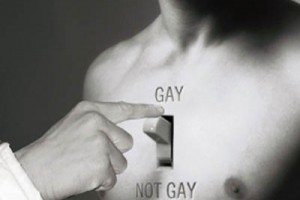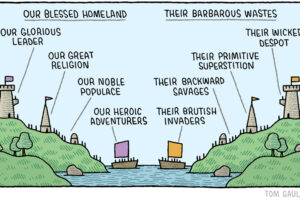I’m fortunate enough to be doing my graduate work at a small, liberal arts college in Southern California, where, in the middle of January, I get to walk to and from class in temperatures ranging from sixty-five to eighty degrees. In all honesty, if you’re running late or forget a book, this walk can seem to be, in the moment, an annoyance. That being said, when I’m not sweating, trying to make it to teach on time, I think that there is some kind of intangible “good” that is occurring when I’m forced to leave the isolation of my car, and be amongst my colleagues and my students. Halfway between my office and the classroom where I teach, stands the library. It is an impressive structure, built in the round, with long, plate glass windows, encircling its face. On days when I’m not lost in some worry or thought about the future, I find myself, vain as it sounds, glancing at my reflection in the glass as I walk past, and then thinking about the person I see there in the window.
In that moment, I see a multiplicity of “me’s”. I first see a man; someone who has self-identified as a male, a representation of some patriarchal menace boiling beneath the surface of my seemingly calm exterior; I also see that I am inordinately tall, something I’ve been reminded of since the age of fifteen, usually by well meaning strangers and grocery store cashiers. This momentary glance also reminds me, in case I’ve had any reason to forget, that I am a black person; this, together with the other me’s that I see in the window constitute my “you”. My “you” is, essentially, the me that others see; it is the image I project out into the world. It’s the you that’s implied whenever someone says, “hey, you!”, if people even say that anymore.
I talk in terms of “projecting an image” because, if I were to stop and study the reflection further, I would notice the details from which my image is composed; the khakis, the button down oxford, the brown leather dress shoes, the skinny tie. Close friends have often joked and said that when I teach I look like Flannery O’ Connor’s Bible salesman in “Good Country People”. If you were to stop me as I was walking and ask why I wear these things, my initial reaction would be to tell you that I am a young teacher and that in order to project a sense of knowledge, experience and authority that may or may not be beyond my years, I must dress to fulfill my student’s expectations of what a college professor should look like.
As I write this, though, there seems to be something deeper, more fundamental at work in the image I choose to project every day; a kind of “not this, but that” element to the clothes I wear, the music I listen too, the books I choose to read. In fact, I’ve come to believe that all this attention to detail, to the image, is my attempt to alter the “you” that people see when they walk past me in the street.
*
When I was in high school, my church friends, who happened to be black, would come to visit me at my parent’s house in Anaheim, CA. We would usually go out to the local Red Robin in Brea, its limitless strawberry lemonade and bottomless seasoned steak fries drawing us into this terribly decorated place. As hedonistic as it sounds, it was actually a deal for a bunch of teenagers who had limited finances to work with. We were good kids, looking back, and we had been taught how to carry ourselves in public. Our only form of gregarious self-expression, if you could even call it that, was to wear extra large t-shirts with popular children’s cartoon characters on them instead of Nike or some surf brand. And yet, as the manager and hostess would talk in hushed tones about where to sit these four little black boys, it would become obvious as we walked past booth after empty booth to be sat either by the kitchen or the emergency exit, that something was amiss. Perhaps they wanted to make sure we could escape quickly in the case of a fire.
*
Again, in high school, a friend and I were crossing the street to go into the Brea Mall, when a pickup truck overflowing with white teenage boys pulled up to the stop light. They rolled down the windows, music blaring and yelled, “Hey! Nigger!” The light turned green, and they sped off. It took me a moment for the shock to wear off and for me to realize that they were not using the term in the same way that I’d heard Jay-Z and 50 Cent using them in the songs I heard on the radio.
*
As a college sophomore, I went with my grandfather to the American South. He took me to Birmingham, AL, the city he had grown up in for most of his young adult life. The Birmingham Black Barons were the local Negro League baseball team and as a boy, my grandfather would go to watch the black athletes play, with his friends. This past Christmas, my sister-in-law got me a hat, that I had asked for, with three B’s on the front and Black Barons scrawled across the back.
The sad truth is that I’ve only worn it twice; I’m ashamed to say it, but there’s a part of me, the boy in me, who grew up hearing about violence and drive-by’s in the streets, that is afraid that because I’m young, tall, black and male, that people will see the three B’s on my hat and assume that it’s supposed to signify some kind of gang affiliation. It does not help that the body of the hat is black and the brim, fire engine red.
*
These are some of the moments that were seminal in the construction of my subjectivity; these are just a sample of the moments in which I realized the gap between who I knew myself to be and what the world thought of when they saw me. I think that I project the image that I do, not to negate any of the visual traits that I mentioned earlier; rather, my projection is an attempt for me to try to embody the things about me that you can’t see in my reflection; my childhood obsession with Japanese anime; the fact that I’m a new father; that my earnest desire as an artist is to be, as James Baldwin says, “an honest man and a good writer.” These are the things I see when I look at my reflection in the plate glass window.
*
My son is eight months old. He is, in a reductionistic way of thinking about it, part me and part my wife. This inevitably means that he is half black like me, and half white like her. What will he see in his own reflections as he grows into a man? How will his subjectivity be constructed? No doubt it will be influenced by both the past and the present. “We are trapped in history and history is trapped in us,” Baldwin famously said. I wonder, now, what my role will be in all of this for him; if there’s any way at all that I can help him to be at peace with the person he see’s staring back at him in the mirror.
That being said, I am comforted by the realization that though the world we live is still fraught with injustice, hatred, and abject cynicism, that even in the midst of all this, my son will have it better than any person who’s looked like him has had it before; that the world, hopefully, will finally be able to see him for who he actually is, as opposed to who they would have wanted, rather, needed him to be in a past iteration of this country and it’s way of life.





Leave a Reply
Your email is safe with us.